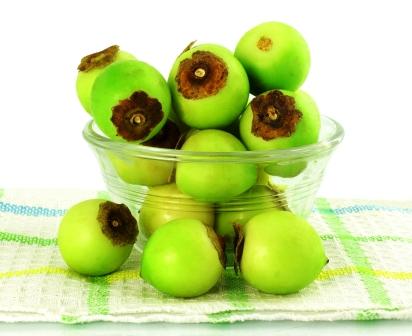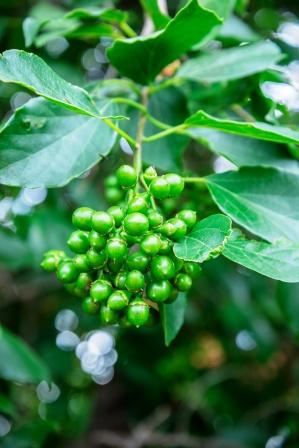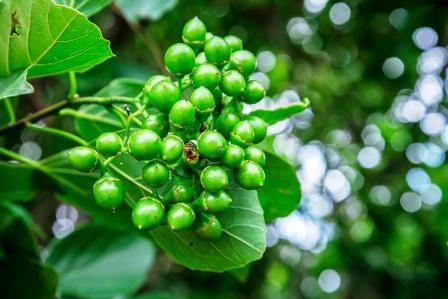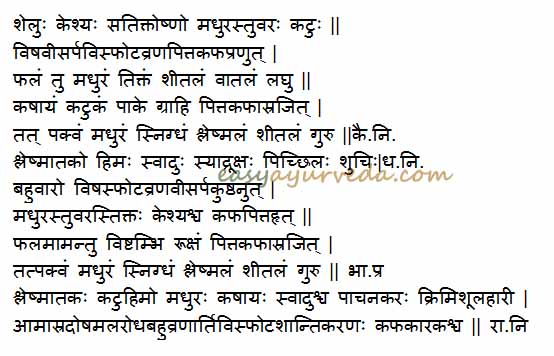Lasoda: Cordia dichotoma: Benefits, Remedies, Research, Side Effects
Shleshmataka – Cordia dichotoma is an Ayurvedic plant, used for the treatment of cough, asthma, skin diseases, fever, diarrhea, intestinal worms and wounds.
Latin name- Cordia dichotoma Forst.
Family- Boraginaceae (Shleshmataka kula)

Table of Contents
Vernacular names
Names in different languages:
Hindi name- Lasoda, Dela, Tenti, Gunda
English name- Sebesten, Glue berry, Pink pearl tree, Bird Lime tree, Fragrant manjack, snotty gobbles, glue berry, anonang, pink pearl, bird lime tree, Indian cherry
Kannada name – Challe Kayi, Challa Kayi, Nakara Hannu. Interestingly, there is a slang dialogue in Kannada, called Challekayi tinnisu – it means, eating lasoda – which actually means to deceive a person.
Tulu name – Challangayi, Challangai, Chellangai
Arabic name- Dilk
Bengali name- Bahanari
Punjabi name- Lasuda
Gujarathi name- Vadagunda
Marathi name- Bhonkar, Bhokar
Nepalese name- Lasura
Telugu name- Nakkera
Tamil name- Vidi
Name in the middle east – Bambar tree.
Tulu name – Challangayi

Properties, part used, dosage
Lasoda Slesmatak – medicinal properties:
Rasa (Taste) – Bark is Kashaya (Astringent), Tikta (Bitter). Fruit is Madhura (Sweet)
Guna (Qualities) – Snigdha (Slimy), Guru (Heavy),
Vipaka – Bark- Katu (Undergoes Pungent taste after digestion), Fruit- Madhura (Sweet)
Veerya (Potency) – Sheeta (Cold)
Karma (Actions) – Fruit is Pitta vata shamaka (reduces vitiated pittaa and vata dosha), Bark is Kapha pitta shamaka (reduces kapha and pitta dosha)
Part used- Fruit and Bark
Dosage:
Decoction of bark- 50 to 70 ml
Fruit juice- 15-20 ml
It is made into pickles, called locally in Hindi as Gunda achar.
Its fruits are eaten raw.

Chemical constituents
Cordia dichotoma chemical constituents:
The leaves of the plant contain B- sitosteryl- 3B- glucopyranoside, chlorophyll and B sitosterol. The twig of the plant has linoleoyl glycerol. The plant also has linolenic acid and allantoin.
Uses
Uses of Shleshmataka – Lasoda
- The immature fruits are made from pickles and also used as vegetable fodder. The leaves also yield good fodder.
- The decoction of the bark is used for cleansing fresh wounds and wounds due to insect bites.
- The decoction of the bark of Cordia dichotoma is given in a dose of 40-50 ml to treat diarrhea, irritable bowel syndrome and intestinal worms.
- The juice of the fresh fruit is given in a dose of 15-20 ml to treat burning sensation of the body and dryness of the body.
- The juice of the fruit is also useful to remove excess phlegm from the lungs and treat cough, asthma.
- The cold infusion of the bark or root is given in a dose of 40-50 ml to treat burning micturition and difficulty in micturition.
- The fruit is consumed to improve the digestive power and indigestion.
- The paste of the root is applied over the area affected with skin diseases like eczema and ringworm.
- The fresh juice of the fruit is known to increase the sperm count in male.
- The decoction of the bark is consumed regularly to improve the general body strength and remove fatigue.
Sanskrit verse

Indications
Bark
Keshya – Improves hair strength, promotes hair growth
Balances Kapha and Pitta Dosha
Indicated in –
Visha – Toxic conditions, poisoning Visarpa – herpes
Visphota – boils, blisters
Vrana – Ulcers, wounds
Unripe Fruit:
Sheetala – coolant
Vishtambi – causes constipation
Vatala – increases Vata Dosha
Kashaya – astringent
Grahi – absorbent, useful in diarrhea, IBS
Balances Kapha and Pitta Dosha
Ripe fruit:
Snigdha – unctuous, oily
Shleshmala – Increases Kapha Dosha
Sheetala – coolant
Guru – heavy to digest
Ayurvedic medicines
Formulations containing Shleshmataka:
Gojihwadi kashaya: This is a medicine in decoction form useful to treat fever, cough, bronchitis, rhinitis etc.
Cofnil plus syrup: It is a proprietary Ayurvedic medicine useful to treat cough and allergic rhinitis.
Virataradi kashaya: It is a medicine in decoction form useful to treat urinary calculi, difficulty in micturition and all ailments due to vata disorders.
P-KOF syrup: It is a proprietary ayurvedic medicine useful to treat cough, cold and allergic conditions.
Interaction with medicines, supplements
Can this be used while taking Homeopathic medicine?
Yes. This product does not react with homeopathic medicine.
Can this medicine be continued while taking supplements like multivitamin tablets, Omega 3 fatty acids etc?
Yes. Generally, this product goes well with most dietary supplements. However, if you are taking more than one product per day, please consult your doctor for an opinion.
With western
medicines
Seek your
doctor’s advice if you are taking this product along with other western
(allopathic / modern) medicines. Some Ayurvedic herbs can interact with modern
medicine.
If both Ayurvedic and allopathic medicines are advised together, then it is
best to take Allopathic medicine first, wait for 30 minutes and then take the
Ayurvedic medicine.
Adverse effect, Research
Adverse effect: No adverse effect is known or reported after the use of Shlesmataka
Research articles related to Cordia dichotoma:
Anti- microbial and Anti-fungal action: Antibacterial activity of methanol and butanol extracts of the bark was carried out against two gram negative bacteria (Escherichia coli, and Pseudomonas aeruginosa) and two Gram positive bacteria (St. pyogenes and Staphylococcus aureus). The antifungal activity of the extracts was carried out against three common pathogenic fungi (Aspergillus niger, A.clavatus, and Candida albicans). The extracts showed remarkable inhibition of the zone of bacterial growth and fungal growth and the results obtained were comparable with that of standard drugs against the organisms tested. The activity of extracts increased linearly with increase in concentration of extract (mg/ml). The results showed the antibacterial and antifungal activity against the organisms tested.
Wound healing action: The extraction of fruits of Cordia dichotoma Forst. f. was carried out using ethanol. This extract was further fractionated using petroleum ether (40-60%), solvent ether, ethyl acetate, butanol and butanone in succession. These fractions were screened for wound healing activity using three different models, viz. excision, incision and dead space wound models on either sex of albino rats of Wistar strain. All the fractions showed significant (P<0.001) activity on the chosen models.
Anti- diabetic action: This study was designed to investigate in vivo hypoglycemic and anti- diabetic potential of methanol extract of fruits of Cordia dichotoma in glucose loaded animals and alloxan induced diabetic animals. In both the models Cordia dichotoma reduced the blood glucose level when compared to diabetic control group and exert a significant hypoglycemic and anti- diabetic activity.
Sanskrit synonyms
Shleshmataka- Expels the Phlegm from the body
Bahubar- Cures many diseases
Shelu- Gives life to men
Uddalaka- Removes the diseases
Gandha pushpa- The flowers have good fragrance
Shapita, Dvijakutsita, karbudara, Bahudara, Seluka, Bahuvaraka, Muktaphala, Vasanta kusuma, Shilu, Lekhasara, Sutapadapa, Lekhasataka, Bhutavrukshaka, Bhutadruma, Gandhapushpa
Morphology
Lasoda is a tree growing to a height of 10-15 m and is seen all over the plains of India. The bark of the stem and trunk is brown. The leaf of the tree looks slimy and smooth. The fruits are whitish in color and bloom during the spring. The fruits are oval, sweet in taste and contain a solitary seed.
Classical categorization
Charaka- Vishagna
Sushrutha- Phala varga
Bhavaprakasha- Amradi phala varga
Dhanvantari Nighantu- Amradi varga
Kaiyyadeva Nighantu- Oushadhi varga
Raja Nighantu- Amradi varga
Shodala Nighantu- Amradi varga
Scientific classification
Kingdom: Plantae
Order: (unplaced)
Family: Boraginaceae
Genus: Cordia
Species: C. dichotoma
Author:
Dr.B.K.Prashanth M.D (Ayu), Ph.D
E mail: [email protected]
Sthanika karma (Systemic Acton)
Externally –Anti poisonous, cleanses the wound, promotes wound healing. indicated in skin disorders. Bark paste and decoction can be applied externally in case of poison, and ear disorders.
Internally
Digestive system – Bark has absorbent and anthelmintic properties. Fruit is indicated in excessive thirst, malabsorption syndrome, and helminthiasis. It can also be used after virechana karma (Purgation therapy) to prevent excess dryness.
Circulatory System – Being cold in potency, beneficial in bleeding disorders.
Respiratory System – Helps to eliminate excess kapha. Juice prepared out of its fruit is indicated in vatika kasa (Cough), running nose. Prevent excess dryness of throat, bronchial area.
Excretory system – Helps to increase urine production. Indicated in painful urination, and burning micturition
Reproductive System – Fruit is aphrodisiac. Indicated in oligospermia
Satmikarana – Bark has an anti poisonous effect. Indicated in general debilitySkin – indicated in skin diseases
Tapakrama – Fruit and bark are indicated in fever











10 comments
mohamedshawqi
this is called bambar fruit in middle east
Dr J V Hebbar MD(Ayu)Author
Thanks for the information. 🙂
Ashraf Latif
I have been eating gunda achar and ripe gunda since my childwood,i love this fruit but did not know about the benerfits.
Parvesh Dhawan
I am very grateful for the information and the knowledge gained from the above .
Sibshankar Jana
what is laosda in bengali language ? I want to know about lasoda, please understood to me in bengali.
Dr J V Hebbar MD(Ayu)Author
It is called Bahanar in Bengali
radhakrishna
In Tulu Challangayi…
but don’t know in Kannada
Dr J V Hebbar MD(Ayu)Author
Thanks. Added the Tulu name.
e
https://en.wikipedia.org/wiki/Cordia_myxa#Toxicity
Cordia myxa contains tumorigenic pyrrolizidine alkaloids
Dr J V Hebbar MD(Ayu)Author
Cardia dichotoma is identified as Lasoda.